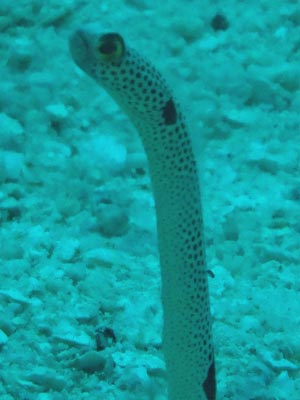|
Michael McFadyen's Scuba Diving - Manta Point, Queensland
Great Detached Reef is located at the northern end of the Great Barrier Reef off Queensland, Australia. It is about 125 nautical miles (230 kilometres) from Thursday Island in the Cape York area (the pointy tip of Australia) and 75 nm (140 kilometres) from Lockhart River. The is 45 nm (85 kilometres) east-north-east from closest point of the Australian mainland, Cape Grenville. It is just over 4 nm south of Raine Island, the largest green turtle nursery in the world.
 |  |
A chart showing the location of Great Detached Reef (bottom right)
and Thursday Island (top left) | Great Detached Reef - Manta Point is the mark |
Great Detached Reef is a reversed C shaped reef made up of a number of separate sections. It is located a little off what is the main outside section of the Great Barrier Reef, although here that reef is merely a series of small bommies or reefs. Great Detached Reef is 11.5 nm from north to south and 8.8 nm east to west. The west (open) side of the reef has a series of bommies and small reefs along a large part of its length.
There are only a couple of boats that travel to this area, one being Kalinda which routinely does full boat charters there in November and December. Another boat does some trips there and one more might go there once or twice a year.
Kelly and I travelled here in November 2016 on Kalinda with fellow members of St George Scuba Club when we chartered the whole boat. We flew into Horn Island (next to Thursday) and started our trip from there.
Manta Point is located on the extreme north-west end of the Great Detached Reef, just inside the actual lagoon. Its location is GPS S11Âș 39' 53.7" E143Âș 59' 12.5". The depth on the top of the reef is about two metres and from here it drops to 12 metres and then gently slopes to the bottom at 25 metres. The slope has lots of isolated coral bommies.
 |  |
| A shot of the reef | One of the garden eels |
The dive here goes east or west till you reach a turn around point and then come back to the anchor area. As you do the outward section, you jump from bommie to bommie and then come back closer to the wall. On the deeper sections we saw a black-tipped reef shark as well as a white-tipped reef shark. There were plenty of titan triggerfish and nests, luckily it was not the nexting season, we were a few weeks early thank heavens.
The sand also has lots of blind shrimp and gobies, as well as thousands of garden eels, so hard to photograph. On the bommies and main wall there are plenty of anemones and clownfish. There are also large numbers of small gorgonias (with gobies), sea whips (with shrimp and gobies) and plenty of different types of coral.
 |  |
| I think this is an African chromodoris | A species of chelidonura, perhaps
chelidonura fulvipunctata, the speckled chelidonura |
There are also large numbers of red bass, plenty of long-finned bannerfish, Moorish idols, some surgeonfish and a few parrotfish. There are also all the normal coral reef fish, from tiny ones to larger species. We saw one large green turtle too.
Safety stops can be done on the wall, there is plenty to see, you will never get bored. On a second dive here we went the opposite direction and had a similar dive.
 |  |
| A shrimp on sea whip | A gobie on a gorgonia |
We dived here in November, the water temperature was about 28ÂșC, visibility about 15 to 20 metres. A nice dive site.
| 
 v6.00.307 © 2003-2005
v6.00.307 © 2003-2005